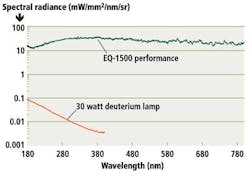LIGHTING AND ILLUMINATION: Broad spectrum light sources employ novel technologies
Many machine vision applications require stable optical light sources that provide high brightness across broad wavelength ranges. To achieve such broad wavelengths has, in the past, required the use of Xenon-arc lamps or more expensive combinations of Tungsten/Halogen, Xenon-arc, and Deuterium lamps.
While gas discharge lamps produce light by exciting an ionized Xenon gas produce white light, the lifetime of such lamps is limited to approximately 2,000 hours during which time the light output diminishes. To overcome this limitation, a number of companies have developed novel technologies that employ both gas discharge and LED technologies.
To produce a spectral output ranging from 170nm to 2100nm, for example, Energetiq Technology (Woburn, MA, USA;www.energetiq.com) has developed a series of laser driven light sources (LDLSs) that employ a custom Xenon lamp.
While the light sources employ a Xenon lamp, the operation of the device achieves a greater than 9,000 hour lifetime by exciting the gas within the bulb in a novel manner. After initially exciting this gas in the traditional manner by striking an electrical arc across tungsten electrodes, a near infrared CW diode laser is used to maintain the energy of the Xenon plasma within the lamp. Then the electrical current to the electrodes is immediately turned off and the plasma is sustained only by the laser diode.
"In traditional Xenon and other arc lamp illumination systems," says Peter Dwyer, Senior Director of Global Sales of Energetiq Technology, "current produced across the electrodes results in a large, millimeter size plasma that has spatially unstable illumination. Focusing the laser to a small spot within the plasma, results in a 100 micrometer diameter plasma that is very hot and very bright with a extremely broad spectrum from the deep UV to the visible and out to the Near IR." Light from the 100 micrometer plasma can then be collected by an optical system and focused free beam or into optical fibers.
Because the electrodes used in the Xenon lamp are not used when the lamp is in continuous use, the lifetime of the lamp is increased dramatically. Although Energetiq Technology's illumination systems are specified to operate for approximately 9,000 hours, tests in the company's lab have shown lifetimes of over 15,000 hours.
To date, the company offers three products that employ the LDLS technology. The first, the LDLS EQ-1500 light source features the company's highest brightness light source that features a 30 mW/mm2/nm/sr spectral radiance while the LDLS EQ-99 is a smaller light source with approximately one third the spectral radiance. Both units are designed for coupling to free-space optics. With the same spectral radiance as the LDLS EQ-99, the LDLS EQ-99FC features an integrated fiber-optic interface collection optics that allows light to be efficiently coupled to small diameter optical fibers.
While such novel technologies are being used to extend the lifetime of traditional Xenon-based systems, other manufacturers are developing LED-based systems that also offer broad wavelength ranges. To produce such broadband illumination, multiple LEDs at different wavelengths can be employed.
In the design of an illumination system to test solar panels, for example, ProPhotonix (Salem, NH, USA;www.prophotonix.com) has developed an LED light source that closely approximates this spectrum. By combining multiple individual chip-on-board LED types, each with a unique spectral profile, the characteristics of the company's LED flat panel closely approximate that of sunlight (see "LEDs challenge Xenon flash lamps in solar panel testing," Vision Systems Design, February 2013; http://bit.ly/1kCl2OM).
Taking a similar approach, Fibertech Optica (FTO; Kitchener, Ontario, Canada;www.fibertech-optica.com) has developed a modular LED platform that is configurable to specific spectral distributions. An integrated light mixing module ensures both spectral and spatial uniformity at the output aperture of a 5mm diameter fiber optic bundle.
The initial configuration spans the visible spectral range using a selection of discrete single wavelength emitters combined with white LEDs.
These light sources can be coupled with other fiber assemblies to create an integrated illumination system.
Vision Systems Articles Archives


